

Unless you have special networking equipment, this can be difficult. While Wireshark does a great job of capturing every packet that flows past it, in some cases you’ll need to analyze a session from a remote server. Sometimes it’s easier to capture traffic on the remote server, then analyze it on your desktop. While Wireshark does a great job of capturing every network packet that flows past it, in some cases you’ll need to analyze a session from a remote server. Sometimes the easiest solution is to use tcpdump to capture traffic on the remote server, and then run Wireshark to take a look at it. Unless you have professional networking equipment, it’s hard to analyze traffic that doesn’t involve your computer. This was a culmination of that info gathering.Wireshark is a powerful tool, but it has its limitations. HTH - There was tons of info out there using Google. The VNC session should be successful and you should be able to launch wireshark from the LXDE desktop. Note we are using port 5900 as displayed when you ran the x11vnc command on the remote computer.

On the computer you want to VNC from, open the VNC client. sudo x11vnc -xkb -noxrecord -noxfixes -noxdamage -display :0 -auth /var/run/lightdm/root/:0 -usepw -scale 1920x1080 -forever Use the directory ~/.vnc to store the password file in. You will get output like the following: root 546 6.4 3.1 614984 122828 ? Sl 06:14 1:52 /usr/lib/xorg/Xorg :0 -seat seat0 -auth /var/run/lightdm/root/:0 -nolisten tcp vt7 -novtswitchįirst create a VNC password. sudo apt install xserver-xorg-video-dummyĬreate nf file in /etc/X11/ and /usr/share/X11/ with the following contents for 1920x1080 resolution: Section "Monitor"

Ok - after TONS of troubleshooting, I managed to successfully launch a new wireshark GUI.įor the benefit of others experiencing the same issue, here's my steps.


 0 kommentar(er)
0 kommentar(er)
